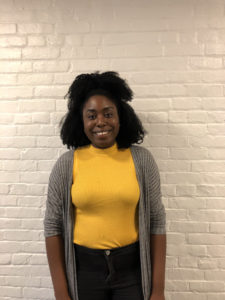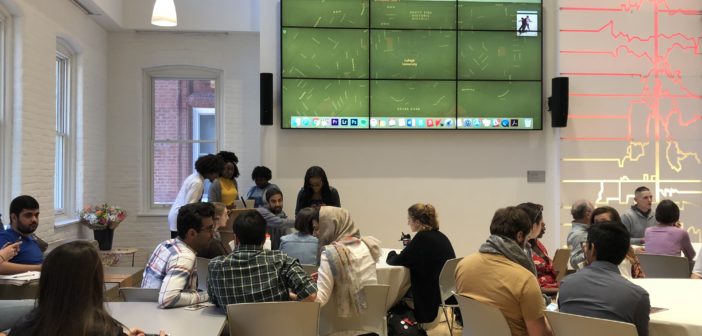The Urban Dictionary definition for Bethlehem, Pennsylvania refers to the city as “Sketchlehem,” “deathlehem,” and “methlehem.” It describes the area surrounding Lehigh University as “the heart of gang land” and cautions those who dare to wander beyond the confines of campus to arm themselves with pepper spray.
The entry is an example of some students’ conception of the area, which locals believe are based in unfounded biases.
On April 24, Ashley Omoma, ’18, presented her two years of research on the history behind these perceptions at an event called “Unmaking Sketchlehem.” When Omoma asked the crowd who had heard of the term, almost every hand shot up.
After hours of researching and forming relationships with local families, Omoma found that “Sketchlehem” is a misconception. Omoma hopes to complete her documentary, “Unmaking Sketchlehem,” a film that brings the true story of Bethlehem to life, by May 10.
“Bethlehem has this rich history, but it’s getting lost with all of the new development that’s happening,” Omoma said. “But there are people here and families here that have worked so hard to make a life for themselves, and they have amazing stories.”
Omoma’s documentary tells the story of locals, like Maureen, from past and present. Maureen, who lived in Bethlehem during the steel boom, said returning to her childhood home reminds her that the town is not what it once was: a family town, filled with memories.
“I can probably name everyone who lived here,” Maureen said. “They were families. There were flowers on the porches. Students don’t think of who used to live here. They think that we’re beneath them, but we’re not.”
Omoma said the South Bethlehem community could not have been more welcoming.

Ashley Omoma, ’18, spent half of her Lehigh career researching the embedded biases that percolate throughout Bethlehem culture. With all she has found, she is creating a documentary titled “Unmaking Sketchlehem” in order to address the issues revolving around people’s misconception of the city. (Shana Lichaw/B&W Staff)
“Their willingness to help a random person tell a story about their lives was amazing,” Omoma said. “People let me into their homes, people let me learn about their lives and I got to establish really good relationships. People were so open to letting me into their homes like I was a new family member.”
But this side of South Bethlehem is often overlooked by the Lehigh community. Omoma found that the divide between Lehigh and South Bethlehem is likely rooted in the contrasting demographics of the communities.
Students at the event generally agreed.
“The wealth gap is definitely the most dividing factor,” Gwladys Boukpessi, ’18, said. “I know that South Bethlehem is a low-income area, but most students at Lehigh are white and from the upper middle class.”
According to the New York Times, 67 percent of Lehigh students come from the top 20 percent of U.S. households. The median income of South Bethlehem families is $49,349, while on average the families of Lehigh students earn $167,600 per year. Omoma said this economic divide has played a role in the making of the term Sketchlehem.
“Students at Lehigh who may not have interacted with so much of that diversity can often think, ‘What is this new place? I don’t know how to interact with this new environment, so I’m just gonna label it as this thing sketchy because I’m not used to it,’“ Omoma said.
But when students look beyond the demographic differences, they find similarities.
“We’re all people and human,” Boukpessi said. “You cannot deny the cultural difference, but we’re all biologically connected.”
As Omoma became more acquainted with community members, she found the community is not only worth exploring, but people’s stories are worth being heard.
“It’s really a land of immigrants, and I think that’s so cool because there’s so much culture here,” Omoma said. “There’s so much about it that I think gets overlooked, but if you actually try to find that out for yourself, you’ll meet a lot of cool people. Establish a better relationship with where you are in the community and the people who actually live here.”
Omoma encourages other Lehigh students to venture into the South Bethlehem community.
“You don’t have a lot of time in the grand scheme of things, but there’s a lot that you can learn in four years,” Omoma said. “Go out into the community. Go out there and find cool people and learn about the history. I think when you do that, you’ll have more respect for the people living here.”






Comment policy
Comments posted to The Brown and White website are reviewed by a moderator before being approved. Incendiary speech or harassing language, including comments targeted at individuals, may be deemed unacceptable and not published. Spam and other soliciting will also be declined.
The Brown and White also reserves the right to not publish entirely anonymous comments.
2 Comments
Bethlehem has ringed LU with public housing and affordable housing complexes. It is such concentrations of poverty that give rise to crime and is a practice that Public Housing Agencies and planners in more progressive areas have corrected starting 20 years ago.
Maybe one day Bethlehem will figure out not to concentrate poverty on the south side of the river.
Until then the area is sketchy and students and parents should be aware.
There are few universities in America set in such a poverty concentrated neighborhood.
Let’s hope for a future where all neighborhoods are economically diverse.
And sadly, the school has little to offer to overcompensate for the fact that the surrounding area is unsafe and, frankly, boring.